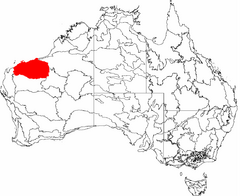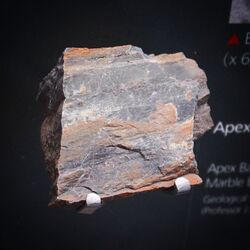Pilbara Craton
Topic: Earth
 From HandWiki - Reading time: 8 min
From HandWiki - Reading time: 8 min
| Pilbara Craton Stratigraphic range: Age Archean[1] | |
|---|---|
 Satellite view in 2013 of Pilbara Craton | |
| Type | Geological formation |
| Area | Estimated 250,000 km2 (97,000 sq mi),[1] Pilbara IRBA v7 region 178,231.26 km2 (68,815.47 sq mi)[2] |
| Thickness | up to 20 km (12 mi) |
| Lithology | |
| Primary | Granite |
| Other | Greenstone |
| Location | |
| Region | Western Australia |
| Country | Australia |
| Type section | |
| Named for | Pilbara |
| Named by | See Pilbara |
 Map of Australia with the Pilbara region highlighted in red. | |
The Pilbara Craton is an old and stable part of the continental lithosphere located in the Pilbara region of Western Australia.
The Pilbara Craton is one of only two pristine Archaean 3.8–2.7 Ga (billion years ago) crusts identified on the Earth, along with the Kaapvaal Craton in South Africa . The youngest rocks are 1.7 Ga old in the historic area assigned to the Craton.[1] Both locations may have once been part of the Vaalbara supercontinent or the continent of Ur.
There are two subregional geographical classification regimes used, being:
- The Interim Biogeographic Regionalisation for Australia based upon interacting geo-ecosystems
- Based on geology alone where the eastern continuous oldest portion is called the Eastern Pilbara Craton and younger surface lithologies within the larger craton have different names.

Geology
The most important part of the Pilbara Craton to understand the early Earth crust is called the Eastern Pilbara Craton, where still exposed today, are crustal rocks that are up to 3.8 billion years old and intrusive granitic domes along with greenstone belts that are about 3.5 to 3.2 billion years old.[1] The geology was reassessed in 2007 with the separation out from the geologically named Pilbara Craton of a thick succession of interbedded clastic or chemical sedimentary rocks and volcanic rocks forming the Fortescue, Hamersley, and Turee Creek basins that are usually aged from 2.78–2.42 billion years old and the younger volcano-sedimentary Ashburton Basin aged from 2.21–1.79 billion years ago.[1] A surface region between the Fortescue and Hamersley basins is even younger, at less than 1.7 billion years old, as are the surrounding geo-ecosystems surface rocks to the Pilbara Craton. It is important to note that to the east and south of the Eastern Pilbara Craton there are significant outcrops of the very old rocks and that these are confined to the traditional area of the Pilbara Craton which is inferred to be subsurface for more than half its area.[1]
Mineralogy
There are extensive high quality iron ore deposits and also economic to mine gold, silver, copper, nickel, lead, zinc, molybdenum, vanadium and fluorite deposits.[1]
Evidence of earliest life
Evidence of the earliest known life on land may have been found in 3.48-billion-year-old geyserite and other related mineral deposits (often found around hot springs and geysers) uncovered in the Dresser Formation in the Pilbara Craton.[3][4][5] Biogenic sedimentary structures (microbialites) such as stromatolites and MISS were described from tidal, lagoonal and subtidal coastal settings that can be reconstructed from the Dresser stratigraphy as well.[6] The rocks of the Dresser Formation display evidence of haematite alteration that may have been microbially influenced.[7]
The earliest direct evidence of life on Earth may be fossils of microorganisms permineralized in 3.465-billion-year-old Australia n Apex chert rocks.[8][9] However, the evidence for the biogenicity of these microstructures has been thoroughly debated.[10][11] Originally, 11 taxa were described from a deposit thought to be located at the mouth of a river due to certain characteristics like rounded and sorted grains.[12][13] Extensive field mapping and petrogenetic analysis has since shown the setting for the purported microfossils to be hydrothermal[14][15] and this is widely supported.[16][17][18][19] Consequently, many alternative abiotic explanations have been proposed for the filamentous microstructures including carbonaceous rims around quartz spherules and rhombs,[14][15] witherite self-assembled biomorphs[20] and haematite infilled veinlets.[21] The carbonaceous matter composing the filaments has also been repeatedly examined with Raman spectroscopy[14][22][21] which has yielded mixed interpretations of results and is therefore regarded by many to be unreliable for determining biogenicity when used alone.[23][24] Perhaps the most compelling argument to date is based on high spatial resolution electron microscopy like scanning and transmission electron microscopy.[19] This study concludes that the nano-scale morphology of the filaments and the distribution of the carbonaceous matter are inconsistent with a biological origin for the filaments. Instead, it is more likely that the hydrothermal conditions have assisted in the heating, hydration and exfoliation of potassium micas on which barium, iron and carbonate have secondarily been adsorbed.
Carbonaceous structures appearing to be of biological origin have also been discovered in the 3.47 billion year-old Mount Ada Basalt, a rock layer that is a few million years older than the Apex chert. However, the biogenicity of these supposed fossils has also been disputed, with some studies finding abiotic processes to be a more likely culprit for their formation.[11]
Additional potential bioindicators from the Precambrian have been found in the region, including carbonaceous microfossils in the northeastern Pilbara Craton.[25]
See also
- Archaea
- Australian Shield
- Centralian Superbasin
- Gawler Craton
- Geology of Australia
- Ore genesis
- Perth Basin
- Western Plateau
- Yilgarn Craton
References
- ↑ 1.0 1.1 1.2 1.3 1.4 1.5 1.6 Hickman and Van Kranendonk, Arthur and Martin (2012). "Early Earth evolution: evidence from the 3.5–1.8 Ga geological history of the Pilbara region of Western Australia". Episodes 35 (1): 283–297. doi:10.18814/epiiugs/2012/v35i1/028. http://aca.unsw.edu.au/sites/default/files/publications/Pilbara_Episodes_2012.pdf.
- ↑ "CAPAD 2014". https://www.dcceew.gov.au/environment/land/nrs/science/capad/2014.
- ↑ Djokic, Tara; Van Kranendonk, Martin J.; Campbell, Kathleen A.; Walter, Malcolm R.; Ward, Colin R. (9 May 2017). "Earliest signs of life on land preserved in ca. 3.5 Ga hot spring deposits". Nature Communications 8: 15263. doi:10.1038/ncomms15263. PMID 28486437. Bibcode: 2017NatCo...815263D.
- ↑ "Dresser Formation - Pilbara". https://pilbara.mq.edu.au/wiki/Dresser_Formation.
- ↑ Noffke, N; Christian, D; Wacey, D; Hazen, RM (December 2013). "Microbially induced sedimentary structures recording an ancient ecosystem in the ca. 3.48 billion-year-old Dresser Formation, Pilbara, Western Australia.". Astrobiology 13 (12): 1103–24. doi:10.1089/ast.2013.1030. PMID 24205812. Bibcode: 2013AsBio..13.1103N.
- ↑ Staff (9 May 2017). "Oldest evidence of life on land found in 3.48-billion-year-old Australian rocks". Phys.org. https://phys.org/news/2017-05-oldest-evidence-life-billion-year-old-australian.html. Retrieved 13 May 2017.
- ↑ Van Kranendonk, Martin J.; Philippot, Pascal; Lepot, Kevin; Bodorkos, Simon; Pirajno, Franco (10 November 2008). "Geological setting of Earth's oldest fossils in the ca. 3.5 Ga Dresser Formation, Pilbara Craton, Western Australia". Precambrian Research 167 (1–2): 93–124. doi:10.1016/j.precamres.2008.07.003. Bibcode: 2008PreR..167...93V. https://www.sciencedirect.com/science/article/abs/pii/S0301926808001551. Retrieved 30 December 2022.
- ↑ Tyrell, Kelly April (18 December 2017). "Oldest fossils ever found show life on Earth began before 3.5 billion years ago". University of Wisconsin-Madison. https://news.wisc.edu/oldest-fossils-ever-found-show-life-on-earth-began-before-3-5-billion-years-ago/. Retrieved 27 December 2017.
- ↑ Schopf, J. William; Kitajima, Kouki; Spicuzza, Michael J.; Kudryavtsev, Anatolly B.; Valley, John W. (2017). "SIMS analyses of the oldest known assemblage of microfossils document their taxon-correlated carbon isotope compositions". PNAS 115 (1): 53–58. doi:10.1073/pnas.1718063115. PMID 29255053.
- ↑ Schopf, J. William (9 May 2006). "Fossil evidence of Archaean life". Philosophical Transactions of the Royal Society B 361 (1470): 869–885. doi:10.1098/rstb.2006.1834. PMID 16754604.
- ↑ 11.0 11.1 Alleon, Julien; Flannery, David T.; Ferralis, Nicola; Williford, Kenneth H.; Zhang, Yong; Schuessler, Jan A.; Summons, Roger E. (13 November 2019). "Organo-mineral associations in chert of the 3.5 Ga Mount Ada Basalt raise questions about the origin of organic matter in Paleoarchean hydrothermally influenced sediments". Scientific Reports 9 (1): 16712. doi:10.1038/s41598-019-53272-5. PMID 31723181. Bibcode: 2019NatSR...916712A.
- ↑ Schopf, J.; Packer, B. (1987-07-03). "Early Archean (3.3-billion to 3.5-billion-year-old) microfossils from Warrawoona Group, Australia" (in en). Science 237 (4810): 70–73. doi:10.1126/science.11539686. ISSN 0036-8075. PMID 11539686. Bibcode: 1987Sci...237...70S. https://www.science.org/doi/10.1126/science.11539686.
- ↑ Schopf, J. W. (1993-04-30). "Microfossils of the Early Archean Apex Chert: New Evidence of the Antiquity of Life" (in en). Science 260 (5108): 640–646. doi:10.1126/science.260.5108.640. ISSN 0036-8075. PMID 11539831. Bibcode: 1993Sci...260..640S. https://www.science.org/doi/10.1126/science.260.5108.640.
- ↑ 14.0 14.1 14.2 Brasier, Martin D.; Green, Owen R.; Jephcoat, Andrew P.; Kleppe, Annette K.; Van Kranendonk, Martin J.; Lindsay, John F.; Steele, Andrew; Grassineau, Nathalie V. (March 2002). "Questioning the evidence for Earth's oldest fossils" (in en). Nature 416 (6876): 76–81. doi:10.1038/416076a. ISSN 1476-4687. PMID 11882895. Bibcode: 2002Natur.416...76B. https://www.nature.com/articles/416076a.
- ↑ 15.0 15.1 Brasier, M.; Green, O.; Lindsay, J.; McLoughlin, N.; Steele, A.; Stoakes, C. (2005-10-21). "Critical testing of Earth's oldest putative fossil assemblage from the ~3.5 Ga Apex chert, Chinaman Creek, Western Australia" (in en). Precambrian Research 140 (1–2): 55–102. doi:10.1016/j.precamres.2005.06.008. ISSN 0301-9268. Bibcode: 2005PreR..140...55B. https://www.sciencedirect.com/science/article/abs/pii/S0301926805000926.
- ↑ Vankranendonk, M. (2006-02-01). "Volcanic degassing, hydrothermal circulation and the flourishing of early life on Earth: A review of the evidence from c. 3490-3240 Ma rocks of the Pilbara Supergroup, Pilbara Craton, Western Australia" (in en). Earth-Science Reviews 74 (3–4): 197–240. doi:10.1016/j.earscirev.2005.09.005. ISSN 0012-8252. Bibcode: 2006ESRv...74..197V. https://www.sciencedirect.com/science/article/abs/pii/S0012825205001431.
- ↑ Pinti, Daniele L.; Mineau, Raymond; Clement, Valentin (September 2009). "Hydrothermal alteration and microfossil artefacts of the 3,465-million-year-old Apex chert" (in en). Nature Geoscience 2 (9): 640–643. doi:10.1038/ngeo601. ISSN 1752-0908. Bibcode: 2009NatGe...2..640P. https://www.nature.com/articles/ngeo601.
- ↑ Olcott Marshall, Alison; Jehlička, Jan; Rouzaud, Jean-Noel; Marshall, Craig P. (2014-01-01). "Multiple generations of carbonaceous material deposited in Apex chert by basin-scale pervasive hydrothermal fluid flow" (in en). Gondwana Research 25 (1): 284–289. doi:10.1016/j.gr.2013.04.006. ISSN 1342-937X. Bibcode: 2014GondR..25..284O. https://www.sciencedirect.com/science/article/abs/pii/S1342937X13001512.
- ↑ 19.0 19.1 Wacey, David; Saunders, Martin; Kong, Charlie; Brasier, Alexander; Brasier, Martin (2016-08-01). "3.46 Ga Apex chert 'microfossils' reinterpreted as mineral artefacts produced during phyllosilicate exfoliation" (in en). Gondwana Research 36: 296–313. doi:10.1016/j.gr.2015.07.010. ISSN 1342-937X. Bibcode: 2016GondR..36..296W. https://www.sciencedirect.com/science/article/abs/pii/S1342937X15001902.
- ↑ Garcia-Ruiz, J. M. (2003-11-14). "Self-Assembled Silica-Carbonate Structures and Detection of Ancient Microfossils" (in en). Science 302 (5648): 1194–1197. doi:10.1126/science.1090163. ISSN 0036-8075. PMID 14615534. Bibcode: 2003Sci...302.1194G. https://www.science.org/doi/10.1126/science.1090163.
- ↑ 21.0 21.1 Marshall, Craig P.; Emry, Julienne R.; Olcott Marshall, Alison (April 2011). "Haematite pseudomicrofossils present in the 3.5-billion-year-old Apex Chert" (in en). Nature Geoscience 4 (4): 240–243. doi:10.1038/ngeo1084. ISSN 1752-0908. Bibcode: 2011NatGe...4..240M. https://www.nature.com/articles/ngeo1084.
- ↑ Schopf, J. William; Kudryavtsev, Anatoliy B.; Agresti, David G.; Wdowiak, Thomas J.; Czaja, Andrew D. (March 2002). "Laser–Raman imagery of Earth's earliest fossils" (in en). Nature 416 (6876): 73–76. doi:10.1038/416073a. ISSN 1476-4687. PMID 11882894. Bibcode: 2002Natur.416...73S. https://www.nature.com/articles/416073a.
- ↑ Pasteris, Jill Dill; Wopenka, Brigitte (2003-12-01). "Necessary, but Not Sufficient: Raman Identification of Disordered Carbon as a Signature of Ancient Life". Astrobiology 3 (4): 727–738. doi:10.1089/153110703322736051. ISSN 1531-1074. PMID 14987478. Bibcode: 2003AsBio...3..727P. https://www.liebertpub.com/doi/10.1089/153110703322736051.
- ↑ Gregorio, Bradley T. De; Sharp, Thomas G. (2006-05-01). "The structure and distribution of carbon in 3.5 Ga Apex chert: Implications for the biogenicity of Earth's oldest putative microfossils" (in en). American Mineralogist 91 (5–6): 784–789. doi:10.2138/am.2006.2149. ISSN 1945-3027. Bibcode: 2006AmMin..91..784D. https://www.degruyter.com/document/doi/10.2138/am.2006.2149/html.
- ↑ Sugitani, Kenichiro (2009). "Taxonomy and biogenicity of Archaean spheroidal microfossils (ca. 3.0 Ga) from the Mount Goldsworthy–Mount Grant area in the northeastern Pilbara Craton, Western Australia". Precambrian Research 173 (1–4): 50–59. doi:10.1016/j.precamres.2009.02.004. Bibcode: 2009PreR..173...50S.
Bibliography
- Kato, Y.; Nakamura, K. (2003). "Origin and global tectonic significance of Early Archean cherts from the Marble Bar greenstone belt, Pilbara Craton, Western Australia". Precambrian Research 125 (3–4): 191–243. doi:10.1016/S0301-9268(03)00043-3. Bibcode: 2003PreR..125..191K.
- Oliver, N. H. S.; Cawood, P.A (2001). "Early tectonic dewatering and brecciation on the overturned sequence at Marble Bar, Pilbara Craton, Western Australia: dome-related or not?". Precambrian Research 105 (1): 1–15. doi:10.1016/S0301-9268(00)00098-X. Bibcode: 2001PreR..105....1O.
- Terabayashi, M.; Masada, Y.; Ozawa, H. (2003). "Archean ocean-floor metamorphism in the North Pole area, Pilbara Craton, Western Australia". Precambrian Research 127 (1–3): 167–180. doi:10.1016/S0301-9268(03)00186-4. Bibcode: 2003PreR..127..167T.
- Zegers, E.; de Wit, M. J.; Dann, J.; White, S. H. (1998). "Vaalbara, Earth's oldest assembled continent? A combined structural, geochronological, and palaeomagnetic test". Terra Nova 10 (5): 250–259. doi:10.1046/j.1365-3121.1998.00199.x. Bibcode: 1998TeNov..10..250Z.
External links
- Deformation and gold mineralisation of the Archaean Pilbara Craton, Western Australia
- Stratigraphic revision of the Warrawoona and Gorge Creek Groups in the Kelly greenstone belt, Pilbara Craton,Western Australia
- Tectonic/Volcanic Landforms
 |
 KSF
KSF

